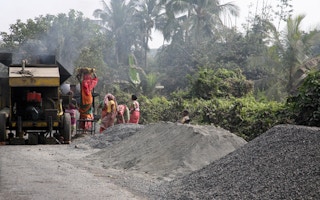WASHINGTON, DC – Consider a simple statistic. Every month in the developing world, more than five million people migrate to urban areas, where jobs, schools, and opportunities of all kinds are often easier to find. But when people migrate, the need for basic services – water, power, and transport – goes with them, highlighting the boom in infrastructure demand.
The reality is evident from Kenya to Kiribati – everywhere where rapid urbanization, the need to support trade and entrepreneurship, and efforts to confront the challenges of climate change have exposed a wide infrastructure deficit. And it is a deficit that confronts advanced economies as well.
Simply put, infrastructure construction and modernization worldwide needs to be part of a strategy for long-term global growth. That is why G-20 finance ministers, meeting recently for the first time this year in Sydney, Australia, singled out investment in infrastructure as one of the elements vital to ensuring a strong, sustainable, and balanced recovery.
But, with G-20 finance ministers preparing to meet again in Washington, DC, next month, a note of caution is in order: Simply increasing infrastructure investment is not enough to foster growth and job creation.
At the start of the financial crisis, both advanced and emerging-market economies pumped money into “shovel-ready” infrastructure projects to boost short-term economic growth and create jobs. Now, in the wake of the crisis, the infrastructure challenge has become more difficult to address. In emerging and developing economies, government budgets are constrained, while the private sector accounts for less than 15% of total infrastructure investment on average.
“
In emerging and developing economies, it is estimated that an additional $1 to 1.5 trillion in annual investment will be required through 2020 to meet growth targets. Factoring in additional spending for reducing greenhouse-gas emissions or adapting to climate change could add $170 to 220 billion each year to the cost of these countries’ infrastructure needs
Indeed, a key challenge in financing infrastructure investment in emerging economies is that many of the commercial banks (mainly European) that had a significant presence in the past have withdrawn – and are unlikely to return until they repair their crisis-hit balance sheets and build capital to meet strengthened regulatory standards.
That leaves huge unmet financing needs. In emerging and developing economies, it is estimated that an additional $1 to 1.5 trillion in annual investment will be required through 2020 to meet growth targets. Factoring in additional spending for reducing greenhouse-gas emissions or adapting to climate change could add $170 to 220 billion each year to the cost of these countries’ infrastructure needs.
Obviously, the G-20 is right to emphasize how important meeting these needs is to how many people. For example, more than 69% of Sub-Saharan Africa’s population lack access to electricity; 65% of people in South Asia lack access to a simple pit latrine; and 40% of rural people in Latin America and the Caribbean lack access to all-weather roads.
But we also know that promoting infrastructure investment requires more than money. Some countries generate massive growth benefits from their infrastructure spending, while others hardly see a return. As a background note prepared by the World Bank Group for the G-20 explains, governments should pay more attention to the selection, quality, and management of infrastructure projects, as well as to the quality of the underlying investment climate.
Prioritizing investments, good planning, and sound project design can significantly boost the impact of new and modernized infrastructure on growth and job creation, as well as raise returns on scarce resources. Better investment planning can also help to avoid locking infrastructure into inefficient and less “green” technologies.
Yes, all of that is easier said than done. As I heard in Sydney, many developing countries face real difficulties in identifying, preparing, and implementing projects. The price tag for technical, financial, economic, and environmental feasibility studies and long-term plans can be high, running into the millions of dollars.
The World Bank Group has been helping developing countries build up their capacity in these areas. But more must be done to enable countries to develop a robust project pipeline that supports a stronger public-investment program, which is critical to any strategy to attract substantial resources from the private sector.
And, in today’s economic climate, attracting private financing is essential, because there is simply no way that public funding alone can close the infrastructure gap. Doing so will also require ensuring appropriate governance, predictable pricing structures, and a credible regulatory environment.
Countries have no time to waste. The unique role of infrastructure in helping to provide basic services for poor people, creating jobs and opportunity, facilitating access to markets, and ensuring sustainable growth in our ever-growing cities requires policymakers to act quickly and decisively.
Bertrand Badré is Managing Director and CFO of the World Bank Group. This post originally appeared in the Project Syndicate.

















